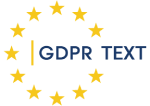(EN) ISO/IEC 27701, adopted in 2019, added additional ISO/IEC 27002 guidance for PII controllers.
Here is the relevant paragraph to article 5(1)(a) GDPR:
7.2.2 Identify lawful basis
Control
The organization should determine, document and comply with the relevant lawful basis for the processing of PII for the identified purposes.
Implementation guidance
Some jurisdictions require the organization to be able to demonstrate that the lawfulness of processing was duly established before the processing.
[…]
Se connecter
lire le texte complet
(EN) EDPB, Guidelines 8/2020 on the targeting of social media users (2020).
(39) Tout traitement de données à caractère personnel devrait être licite et loyal. Le fait que des données à caractère personnel concernant des personnes physiques sont collectées, utilisées, consultées ou traitées d'une autre manière et la mesure dans laquelle ces données sont ou seront traitées devraient être transparents à l'égard des personnes physiques concernées. Le principe de transparence exige que toute information et communication relatives au traitement de ces données à caractère personnel soient aisément accessibles, faciles à comprendre, et formulées en des termes clairs et simples. Ce principe vaut, notamment, pour les informations communiquées aux personnes concernées sur l'identité du responsable du traitement et sur les finalités du traitement ainsi que pour les autres informations visant à assurer un traitement loyal et transparent à l'égard des personnes physiques concernées et leur droit d'obtenir la confirmation et la communication des données à caractère personnel les concernant qui font l'objet d'un traitement. Les personnes physiques devraient être informées des risques, règles, garanties et droits liés au traitement des données à caractère personnel et des modalités d'exercice de leurs droits en ce qui concerne ce traitement. En particulier, les finalités spécifiques du traitement des données à caractère personnel devraient être explicites et légitimes, et déterminées lors de la collecte des données à caractère personnel. Les données à caractère personnel devraient être adéquates, pertinentes et limitées à ce qui est nécessaire pour les finalités pour lesquelles elles sont traitées. Cela exige, notamment, de garantir que la durée de conservation des données soit limitée au strict minimum. Les données à caractère personnel ne devraient être traitées que si la finalité du traitement ne peut être raisonnablement atteinte par d'autres moyens. Afin de garantir que les données ne sont pas conservées plus longtemps que nécessaire, des délais devraient être fixés par le responsable du traitement pour leur effacement ou pour un examen périodique. Il y a lieu de prendre toutes les mesures raisonnables afin de garantir que les données à caractère personnel qui sont inexactes sont rectifiées ou supprimées. Les données à caractère personnel devraient être traitées de manière à garantir une sécurité et une confidentialité appropriées, y compris pour prévenir l'accès non autorisé à ces données et à l'équipement utilisé pour leur traitement ainsi que l'utilisation non autorisée de ces données et de cet équipement.
(39) Any processing of personal data should be lawful and fair. It should be transparent to natural persons that personal data concerning them are collected, used, consulted or otherwise processed and to what extent the personal data are or will be processed. The principle of transparency requires that any information and communication relating to the processing of those personal data be easily accessible and easy to understand, and that clear and plain language be used. That principle concerns, in particular, information to the data subjects on the identity of the controller and the purposes of the processing and further information to ensure fair and transparent processing in respect of the natural persons concerned and their right to obtain confirmation and communication of personal data concerning them which are being processed. Natural persons should be made aware of risks, rules, safeguards and rights in relation to the processing of personal data and how to exercise their rights in relation to such processing. In particular, the specific purposes for which personal data are processed should be explicit and legitimate and determined at the time of the collection of the personal data. The personal data should be adequate, relevant and limited to what is necessary for the purposes for which they are processed. This requires, in particular, ensuring that the period for which the personal data are stored is limited to a strict minimum. Personal data should be processed only if the purpose of the processing could not reasonably be fulfilled by other means. In order to ensure that the personal data are not kept longer than necessary, time limits should be established by the controller for erasure or for a periodic review. Every reasonable step should be taken to ensure that personal data which are inaccurate are rectified or deleted. Personal data should be processed in a manner that ensures appropriate security and confidentiality of the personal data, including for preventing unauthorised access to or use of personal data and the equipment used for the processing.

(EN) Example of lawful processing:
Source: EDPB, Guidelines 4/2019 on Article 25 – Data Protection by Design and by Default (Version for public consultation) (2019).
(EN) Example of transparency measures:
Source: EDPB, Guidelines 4/2019 on Article 25 – Data Protection by Design and by Default (Version for public consultation) (2019).
(EN) Examples of fairness considerations:
Example 1
Source: EDPB, Guidelines 4/2019 on Article 25 – Data Protection by Design and by Default (Version for public consultation) (2019).